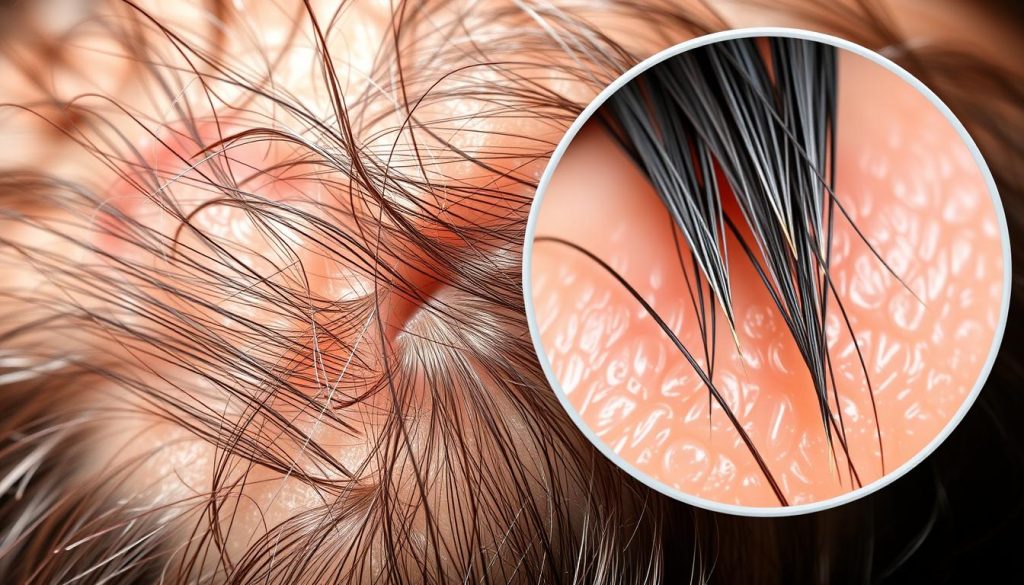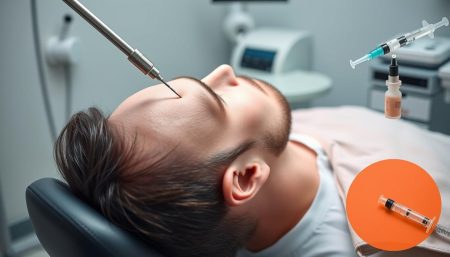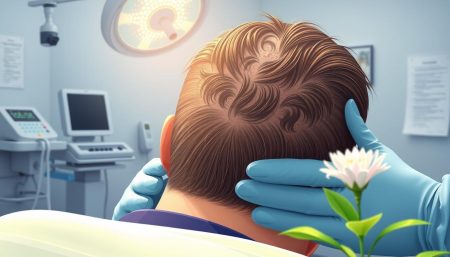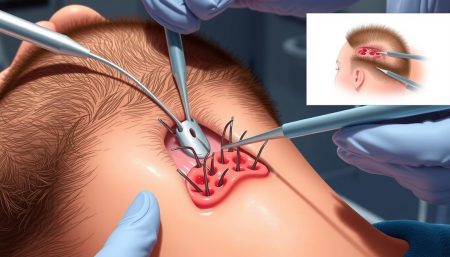Many people wonder if a hair transplant procedure can not only fix their hairline but also change their hair texture changes. They hope to understand how hair restoration results can affect their hair’s texture. This is a big deal for personal looks and identity, making many curious and hopeful.
As hair restoration science gets better, it’s key to know what to expect. Can a hair transplant change the feel of your hair? This article will help you understand the link between hair surgery and your hair’s feel after. It answers the question: can a hair transplant really change your hair’s nature?
To really get it, talking to hair transplant experts is crucial. They know how different hair transplant techniques affect hair. This way, you can make a smart choice about getting a hair transplant.
Key Takeaways
- Exploration of hair texture transformation potential post-hair transplant.
- Insight into the nuances of hair transplant techniques and their effects on hair texture.
- Guidance for setting realistic hair restoration results expectations.
- Understanding the importance of expert consultation in hair restoration.
- Identification of considerations prior to undergoing a hair transplant with respect to hair texture.
Understanding Hair Transplant Techniques
The world of hair restoration has seen big changes. New hair transplant techniques have made procedures better and patients happier. Follicular Unit Extraction (FUE) and Follicular Unit Transplantation (FUT) are leading the way in hair restoration.
The Basics of FUE and FUT Procedures
Follicular Unit Extraction (FUE) and Follicular Unit Transplantation (FUT) are top hair transplant methods. They move hair follicles from a donor site to thinning or balding areas. But, how they get the follicles is different.
- Follicular Unit Extraction (FUE): FUE takes out individual hair follicles from the scalp with small punches. It’s less invasive and doesn’t leave scars. It’s great for those who want short hair or can’t handle much pain.
- Follicular Unit Transplantation (FUT): FUT takes a strip of scalp, then cuts it into follicular units under a microscope. It’s good for covering large areas and is more affordable for big jobs.
Both methods have their benefits. The right choice depends on the patient’s hair loss, lifestyle, and beauty goals.
Latest Advancements in Hair Restoration Techniques
Hair restoration is getting better with new technologies. These advancements make hair transplants more efficient and effective. New tools and growth factors are helping hair grow better after transplant.
Robotic FUE is a big step forward. It uses robots for precise hair extraction. This reduces mistakes and makes the results look better. Better solutions for keeping transplanted hair alive also mean fuller, more natural-looking hair.
With ongoing improvements, these hair transplant techniques are changing lives. They not only make people look better but also feel more confident and happy.
Hair Texture and Its Determining Factors
The uniqueness of hair texture and its variations is fascinating. Hair texture refers to the natural shape of hair strands. It can be straight, wavy, or curly. Knowing what influences this trait helps us understand how hair might change after a transplant.
Genetic factors in hair type are key in determining hair texture. The shape of the hair follicle characteristics and how it tunnels into the scalp affect hair’s shape. But, other factors can also change hair texture over time.
“Hair’s nature can tell a story about who you are and even indicate certain health traits, which are largely predetermined by genetic factors in hair type.”
- DNA dictates hair texture by controlling the shape and angle of the hair follicle.
- Hormonal changes can alter hair texture, seen during pregnancy or puberty.
- Environmental conditions like humidity and temperature play a role too.
- Dietary intake and overall health can affect hair’s luxuriance and texture.
Thinking about a hair transplant and its effects on hair texture is important. Post-operative hair texture might be similar to pre-operative texture. This is because the genetic factors in hair type are transferred with the follicle. But, the adaptation of transplanted hair to a new location might also cause subtle texture changes.
| Hair Type | Follicle Shape | Texture Feature |
|---|---|---|
| Straight | Oval | Flat, Sleek |
| Wavy | Slightly Curved | Flowing Waves |
| Curly | Curved | Tight Curls |
This detailed breakdown shows the complexity of hair follicle characteristics and their role in hair texture. Understanding these variables can help us grasp potential changes after a hair restoration procedure.
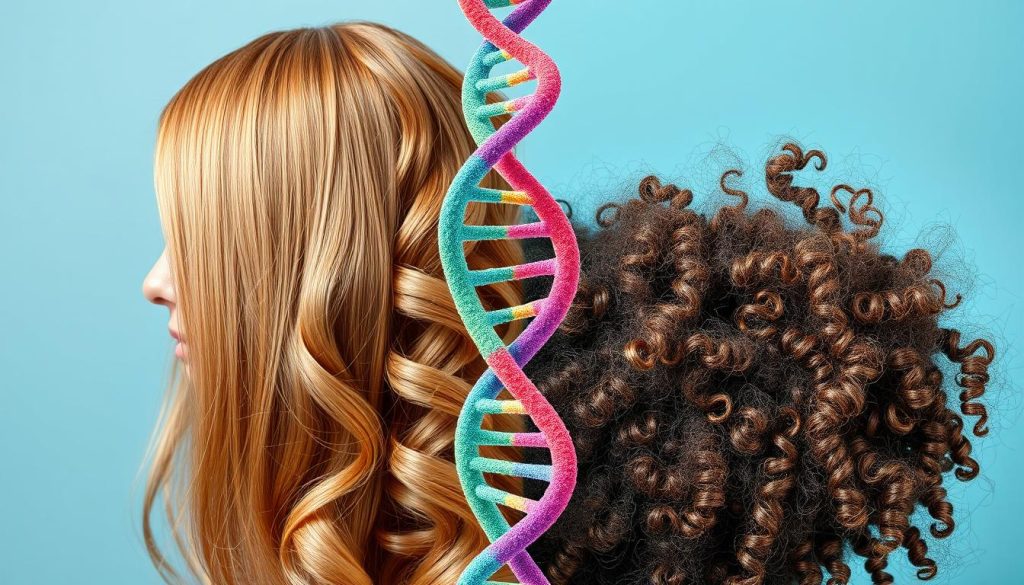
Can You Change Your Hair Texture With a Hair Transplant
Many people wonder if hair transplants can change their hair texture. They want to not only grow back their hair but also change hair texture with a hair transplant. Looking at hair transplant results can help set realistic expectations.
Realistic Expectations from Hair Transplant Procedures
A hair transplant moves hair from one scalp area to another. It doesn’t change hair texture or color. The transplant doesn’t change hair follicle genetics, which control texture. But, the transplant method can make the hair look and feel different. Learn more about different hair textures and.
Case Studies and First-Hand Experiences
Listening to those who’ve had the transplant can give insight into changing hair type after. Here’s a quick look at a few examples:
| Patient | Original Hair Type | Transplanted Hair Type | Perceived Change in Texture |
|---|---|---|---|
| Alice | Wavy | Wavy | None |
| Bob | Straight | Straight | None |
| Clara | Curly | Curly | Slightly more defined curls |
These examples show that while hair texture usually stays the same, small changes can happen. Clara’s hair, for instance, might look slightly different due to how the transplant was done.
The Role of Hair Follicles in Determining Hair Texture
Understanding hair follicle characteristics is key for hair restoration and knowing your hair type. Each follicle on your scalp is set to grow a certain type of hair. This includes everything from curl pattern to thickness. This genetic setting of the follicle makes changing hair texture through transplant tricky.
When talking about hair restoration, it’s vital to know that transplanted follicles keep their original traits. So, the hair’s texture, whether it’s straight, wavy, or curly, stays the same before and after transplant.

But, how the follicles are placed during a hair restoration can change how your hair looks. Skilled surgeons use their knowledge of hair follicle characteristics to place them for the best look. This helps the new hair blend in naturally with your existing hair type.
| Hair Type | Characteristics | Impact on Transplant Outcome |
|---|---|---|
| Straight | Flat cross-section | Consistent texture post-transplant |
| Wavy | Oval cross-section | Mild variability in texture |
| Curly | Elliptical cross-section | High preservation of curls |
In conclusion, while hair follicle characteristics play a big role in your natural hair type, the skill of the surgeon is also crucial for hair restoration success. Knowing these details helps people have realistic hopes from their hair transplant.
Curly Hair Transplant: Is It Possible?
Many people are curious about curly hair transplants. They want to restore their hair and keep its unique texture. But, making hair transplant work for curly hair is tricky.
Challenges in Transplanting Curly Hair Follicles
Curly hair grows in a spiral shape. This makes it harder to take out and put back in during a transplant. Doctors need to be very careful to avoid damaging the hair follicles.
Curly to Straight Hair: What to Expect
Some might dream of changing their hair from curly to straight with a transplant. But, the new hair will only be as curly as the donor hair. Changing hair type completely is not possible with just a transplant.
In short, a curly hair transplant is doable and can look great. But, it needs a skilled doctor to handle the special needs of curly hair. Patients should talk clearly with their surgeon about what they can expect. This ensures they’re happy with the results and their hair stays healthy.
Wavy Hair Transplant: Techniques and Results
Getting a successful wavy hair transplant depends on the right hair transplant techniques. These techniques need to fit different hair textures. It’s important to know how to make wavy hair transplants work well.
Adapting the Procedure for Different Hair Textures
One big challenge in wavy hair transplants is keeping the hair’s natural wave. Choosing the right donor hairs and using precise techniques is key. This makes sure the hair looks natural and boosts the transplant’s success.
Success Stories of Wavy Hair Transplants
Many people have seen big improvements in their hair after a wavy hair transplant. They’ve noticed better coverage and their natural wave is still there. These stories show how new hair transplant methods can change someone’s look and confidence.
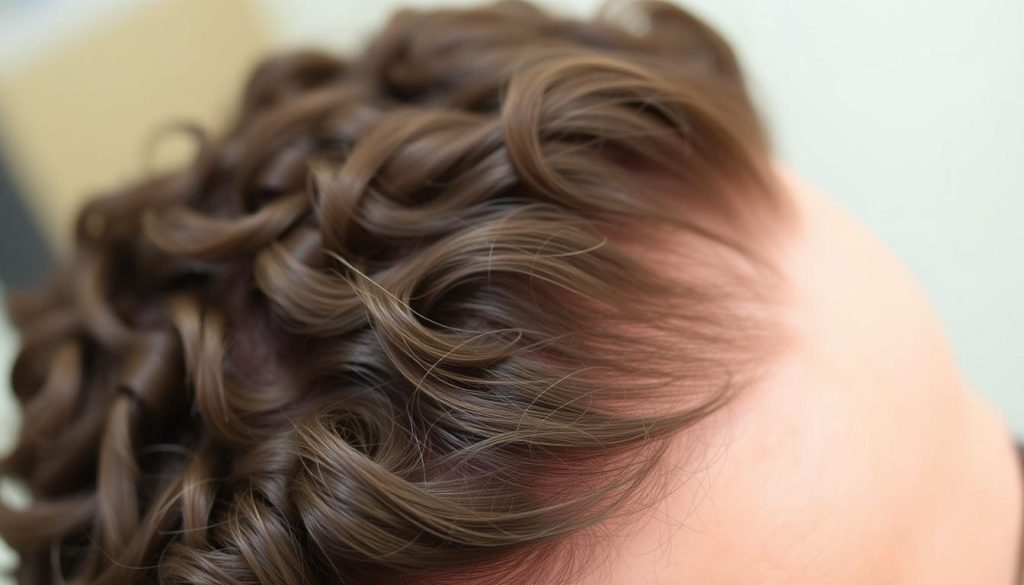
Thanks to skilled surgeons and new methods, more people are getting their wavy hair back. This is especially true for those looking to restore or improve their wavy hair.
| Technique | Description | Adaptability to Wavy Hair |
|---|---|---|
| FUE (Follicular Unit Extraction) | Individual follicles are extracted directly from the scalp without a strip of tissue. | High – preserves natural hair texture. |
| FUT (Follicular Unit Transplantation) | A strip of scalp is removed, and follicles are extracted from this strip. | Moderate – requires careful handling to maintain wave integrity. |
| DHI (Direct Hair Implantation) | Direct implantation of follicles into the scalp using a precise pen-like device. | Very High – enhances placement accuracy for natural wave patterns. |
The way wavy hair transplants are done shows how important it is to match the technique to the hair. The results are not just about the hair’s structure. They also bring back the hair’s natural look, making each success story special.
Does Hair Restoration Truly Restore Natural Hair Characteristics?
People often wonder if hair restoration results truly match their natural hair. They question the authenticity of hair transplant authenticity in bringing back their hair’s natural look and feel. This is a big deal because a successful transplant isn’t just about growing hair. It’s also about how well that hair looks and acts like the real thing.
Whether hair restoration can truly restore natural hair depends on a few things. These include the technology used, the surgeon’s skill, and the patient’s original hair quality. New methods and techniques aim to improve hair density and look. They try to match the patient’s hair texture and growth pattern as closely as possible.
- Technological advances: Modern tools and methods allow for more precise hair follicle extraction and placement.
- Skilled surgeons: Experienced surgeons can better replicate the natural growth pattern of hair, which is crucial for maintaining its natural characteristics.
- Individual characteristics: Each patient’s unique hair texture, color, and growth rate play a significant role in the overall hair transplant authenticity.
But, it’s key to have realistic hopes. Today’s methods can closely mimic natural hair, but it’s not perfect. The texture might be a bit off, or the hairline might not be exactly the same. It’s important for patients to talk to their surgeons about what hair restoration results they can expect.
The search for true-to-life hair transplants is a continuous effort. As technology and techniques improve, we get closer to achieving results that are seamless and natural. This is what many patients hope to regain.
Changing Hair Type After a Transplant: Myth vs. Reality
Many people think a hair transplant can change their hair type. This section looks into these claims and clears up common hair restoration myths.
Understanding the Limitations of Hair Transplantation
Hair transplants can make your hair look fuller and better. But, there are hair transplant limitations to know. A transplanted hair follicle keeps the same traits as the donor hair. This means changing hair type, like from curly to straight, isn’t possible.
Debunking Common Myths About Hair Restoration
One big hair restoration myth is that hair texture can be totally changed by transplant. These myths can lead to false hopes about hair restoration results. We aim to clear up these misunderstandings and show what’s really achievable.
- Transplanted hair will mimic the characteristics and type of the donor area.
- Texture changes are not a result of the transplant procedure itself.
- Genetic factors predominantly dictate hair type, rather than the transplantation process.

| Common Belief | Reality |
|---|---|
| Transplant can change hair type | The type remains consistent with the donor hair characteristics |
| Transplant can create new hair texture | Texture is genetically determined, transplantation does not alter it |
| Results are universally predictable | Outcomes vary based on individual characteristics and genetic factors |
Case Studies: Hair Transplant Results and Textural Changes
Looking at the differences in hair texture outcomes after a transplant helps us understand what patients can expect. We examine hair transplant case studies to see how hair looks in the short and long term.
These studies show more than just hair growth. They also highlight changes in hair texture and how happy patients are with the results.
| Patient | Initial Hair Texture | Texture One Year After Transplant | Overall Satisfaction |
|---|---|---|---|
| Patient A | Fine, Straight | Fine, Slightly Wavy | High |
| Patient B | Thick, Curly | Thick, Maintained Curly | Very High |
| Patient C | Coarse, Wavy | Coarse, More Defined Waves | Moderate |
The hair transplant case studies show it’s possible to get the hair texture you want. They also stress the need to have clear expectations with your hair specialist. The hair transplant before and after photos in these studies help future patients see what they might look like.
Preoperative Considerations for Desired Hair Texture Outcomes
Starting a hair transplant journey means you need to plan well. It’s important to preoperative planning. You must talk clearly about the hair texture you want to your surgeon. This helps create a customized hair transplant plan that matches your dreams.
How to Communicate Your Expectations to a Surgeon
Make sure your surgeon knows what you want. Talk about the hair texture you dream of. You might show pictures or talk about the styles you like based on your hair’s growth.
It’s key for the surgeon to get both your wishes and what’s possible with your hair type. This way, you both are on the same page.
The Importance of a Customized Hair Transplant Plan
Every hair transplant is unique. Different scalps and hair types need special care. This care is crucial for the best results and looks.
Working closely with your surgeon helps create a plan just for you. It takes into account your hair’s special traits and what you hope to see.

Postoperative Care: Ensuring the Best Hair Texture Results
Getting the best results from a hair transplant aftercare is key. It’s not just about healing, but also keeping your hair healthy and looking good. Knowing the basics of postoperative care can make a big difference. Here are some tips and routines to help you get the best results.
- Immediate Care: Don’t touch or wash the transplant area for the first 48 hours. This helps prevent infection and keeps the new grafts safe.
- Hydration and Nutrition: Drinking plenty of water and eating foods rich in nutrients helps your body heal faster. It also keeps your hair follicles healthy.
- Gentle Hair Care: When you can wash your hair, use gentle, sulfate-free shampoos. This helps keep the hair follicles strong.
- Avoid Direct Sunlight: Keep your scalp away from direct sunlight. Wear a hat or use an umbrella for a few weeks after the transplant.
- Limit Physical Activity: Avoid heavy activities that can make you sweat a lot. This reduces stress on your scalp.
- Follow-up Treatments: Make sure to go to all your scheduled postoperative visits. This helps your doctor check on the health and progress of your transplant.
Every step in hair transplant aftercare is important. It’s not just about healing. It’s also about keeping your hair healthy and looking natural. Sticking to these aftercare steps is crucial for the best results.
Comparing Hair Transplant Results: Before and After
When we look at hair transplant success, before and after photos are key. They show not just new hair growth but also changes in hair texture. Comparing hair transplant results through photographic evidence helps surgeons and patients see how well the procedure worked.
Analyzing Photographic Evidence of Texture Change
Before-and-after photos are clear proof of a hair transplant’s success. They show not just a fuller hairline but also changes in hair texture. These photos highlight details like curl pattern, hair thickness, and quality, proving if the hair looks natural.
Testimonials and Patient Satisfaction with Hair Texture
While photos confirm the results, patient testimonials add a personal touch. People who’ve had the procedure share their experiences, talking about their new hair’s feel and movement. Their stories help others understand what to expect, making the decision easier.
FAQ
Q: Can a hair transplant change your hair texture?
A: Generally, a hair transplant doesn’t change your hair’s texture. It moves your own hair follicles. But, changes in hair care after the transplant might slightly affect how it feels.
Q: What are the basic differences between FUE and FUT hair transplant techniques?
A: FUE and FUT are two main hair transplant methods. FUE takes each hair follicle one by one. FUT removes a scalp strip and then gets follicles from it.
Q: What are some recent advancements in hair restoration techniques?
A: New tech like robotic hair transplants and better graft survival are improving results. These advancements help in more precise hair placement.
Q: How does hair texture relate to hair follicles?
A: Hair texture comes from the shape of your hair follicle. Round follicles make straight hair. Oval and twisted ones make wavy and curly hair.
Q: What realistic expectations should I have regarding hair texture after a transplant?
A: Expect your transplanted hair to feel like your donor hair. Transplants don’t change hair texture. Any texture change is likely from hair health or styling.
Q: Are there specific challenges associated with transplanting curly hair follicles?
A: Yes, curly hair follicles are tricky to transplant. They need precise placement to keep their natural curl.
Q: If I have curly hair, can I expect it to be straight after a hair transplant?
A: No, curly hair stays curly after a transplant. The new hair comes from follicles with the same characteristics.
Q: How can hair transplant procedures be adapted to different hair textures like wavy hair?
A: Surgeons adjust techniques for wavy hair. They consider the angle and direction of hair placement for a natural look.
Q: Can hair restoration truly replicate my natural hair’s characteristics?
A: Hair restoration tries to match your natural hair as closely as possible. But, remember, results can vary.
Q: Is it a myth that a hair transplant can change your hair type?
A: Yes, it’s a myth. A hair transplant won’t change your hair type or texture. It just moves existing hair, keeping its original feel.
Q: What limitations should I be aware of with hair transplantation?
A: Hair transplantation can’t grow new hair. It only moves what you already have. There are limits to donor hair and texture preservation.
Q: How should I communicate my expectations for hair texture to my surgeon?
A: Be clear about what you want. Share pictures and ask questions. A good surgeon will set realistic expectations.
Q: Why is a customized hair transplant plan important for achieving desired texture outcomes?
A: A customized plan considers your hair and scalp. It ensures techniques enhance your natural texture as much as possible.
Q: What postoperative care should I follow to ensure the best hair texture results?
A: Follow your surgeon’s advice. This includes gentle washing, avoiding harsh chemicals, and taking medications. Regular follow-ups are also key.
Q: How significant are before and after photos in evaluating texture changes following a hair transplant?
A: Before and after photos are very important. They show the success of the transplant and any texture changes.
Q: What are some testimonials about hair texture satisfaction after a transplant?
A: Many patients are happy with their hair texture after a transplant. They say their new hair blends well with their existing hair.












